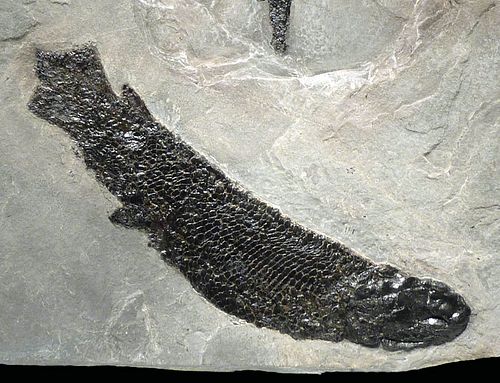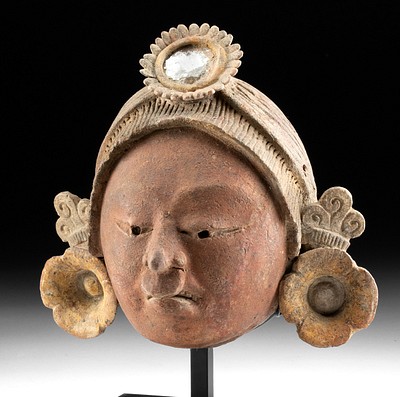Fossilized Lungfish Gyroptychius & Osteolepsis Matrix
Lot 86
About Seller
Artemis Fine Arts
686 S Taylor Ave, Ste 106
Louisville, CO 80027
United States
Selling antiquities, ancient and ethnographic art online since 1993, Artemis Gallery specializes in Classical Antiquities (Egyptian, Greek, Roman, Near Eastern), Asian, Pre-Columbian, African / Tribal / Oceanographic art. Our extensive inventory includes pottery, stone, metal, wood, glass and textil...Read more
Categories
Estimate:
$8,000 - $12,000
Absentee vs Live bid
Two ways to bid:
- Leave a max absentee bid and the platform will bid on your behalf up to your maximum bid during the live auction.
- Bid live during the auction and your bids will be submitted real-time to the auctioneer.
Bid Increments
| Price | Bid Increment |
|---|---|
| $0 | $25 |
| $300 | $50 |
| $1,000 | $100 |
| $2,000 | $250 |
| $5,000 | $500 |
| $10,000 | $1,000 |
| $20,000 | $2,500 |
| $50,000 | $5,000 |
| $100,000 | $10,000 |
| $200,000 | $20,000 |
About Auction
By Artemis Fine Arts
Jul 14, 2022
Set Reminder
2022-07-14 10:00:00
2022-07-14 10:00:00
America/New_York
Bidsquare
Bidsquare : Exceptional Antiquities Ethnographica Fine Art
https://www.bidsquare.com/auctions/artemis-gallery/exceptional-antiquities-ethnographica-fine-art-9692
Museum-worthy examples of classical antiquities (Egyptian, Greek, Roman, Near Eastern), Viking, Far East / Asian, Pre-Columbian, African / Tribal, Oceanic, Native American, Spanish Colonial, Fossils, Ancient Jewelry, Fine / Visual Arts, so much more! Artemis Fine Arts info@artemisfinearts.com
Museum-worthy examples of classical antiquities (Egyptian, Greek, Roman, Near Eastern), Viking, Far East / Asian, Pre-Columbian, African / Tribal, Oceanic, Native American, Spanish Colonial, Fossils, Ancient Jewelry, Fine / Visual Arts, so much more! Artemis Fine Arts info@artemisfinearts.com
- Lot Description
Northwestern Europe, Scotland, Orkney, Old Red Sandstone Formation, Middle Devonian, ca. 380 million years ago. This large stone displays two incredible fish fossils from rhipidistians, freshwater fish that eventually evolved into the earliest terrestrial tetrapods! These preserved remains are excellent and of fine quality. The largest is a primitive lungfish known as Gyroptychius agassizi - with a lengthy, streamlined body, and the other fish is a lobed-finned relative known as Osteolepis- both covered with armored plates in the head and heavy scales. This is a choice grade example of a Gyroptychius fossil due to its stunning state of completeness and size! The scale articulation is exceptional as well as is the full array of fins and tail, even the delicate caudal fin and thoracic fins are natural and well-preserved! Size (Gyroptychius fossil): 13.25" L (33.7 cm); (Osteolepis fossil): 5" L (12.7 cm); (matrix): 19" L x 13.25" W (48.3 cm x 33.7 cm)
At a period in time when vertebrates were scarce on Earth and trilobites thrived in enormous varieties and numbers, these fish of the Devonian, graced a freshwater lake in the region that is now Northern Scotland. The Devonian Period is the first era on Earth of fish emerging in the fossil record. Gyroptychius agassizi was a predatory lungfish, a lobe-finned bony fish that had the capability to breathe air by the use of their modified air bladder consisting of multiple chambers. They possessed odd large ridged toothplates designed to crush as much as chew their prey. Gyroptychius had a long, slender body with a shallow head and small eyes and arranged in diagonal rows were thick rhombic scales made up of a cosmine layer and a thin shiny ganoine layer. These primitive fish also possessed a bizarre rhomboid-shaped caudal fin.
The Old Red Sandstone layers of Northern Scotland are one of three of the world's most scientifically important and richest deposits yielding fossil fish from the Devonian. The other two sites are at Canowindra in New South Wales and Miguasha in Quebec. A wide variety of freshwater fish can be found in these layers in Scotland from a time when the very first four-limbed vertebrates were evolving. The Achanarras beds, named after the quarry where they were first discovered, can be found in the layers that were laid down in Lake Orcadie during the Devonian period, 380 million years ago. Achanarras Quarry is situated at the top of a hill and is not very large. Since the quarry is now closed, the main central portion is flooded and inaccessible. Many years ago, it was worked for the laminated limestone which was split for roofing slates. The site is littered with a vast amount of slabs, but whole fish are rare and easily broken when found.
Provenance: ex-private German collection before 2011
All items legal to buy/sell under U.S. Statute covering cultural patrimony Code 2600, CHAPTER 14, and are guaranteed to be as described or your money back.
A Certificate of Authenticity will accompany all winning bids.
PLEASE NOTE: Due to recent increases of shipments being seized by Australian & German customs (even for items with pre-UNESCO provenance), we will no longer ship most antiquities and ancient Chinese art to Australia & Germany. For categories of items that are acceptable to ship to Australia or Germany, please contact us directly or work with your local customs brokerage firm.
Display stands not described as included/custom in the item description are for photography purposes only and will not be included with the item upon shipping.
#172847Choice and intact, no repairs or restoration. Protective sealer applied to fossils.Condition
- Shipping Info
-
All shipping is handled in-house for your convenience. Your invoice from Artemis Gallery will include shipping calculation instructions. If in doubt, please inquire BEFORE bidding for estimated shipping costs for individual items.
-
- Buyer's Premium



 EUR
EUR CAD
CAD AUD
AUD GBP
GBP MXN
MXN HKD
HKD CNY
CNY MYR
MYR SEK
SEK SGD
SGD CHF
CHF THB
THB












